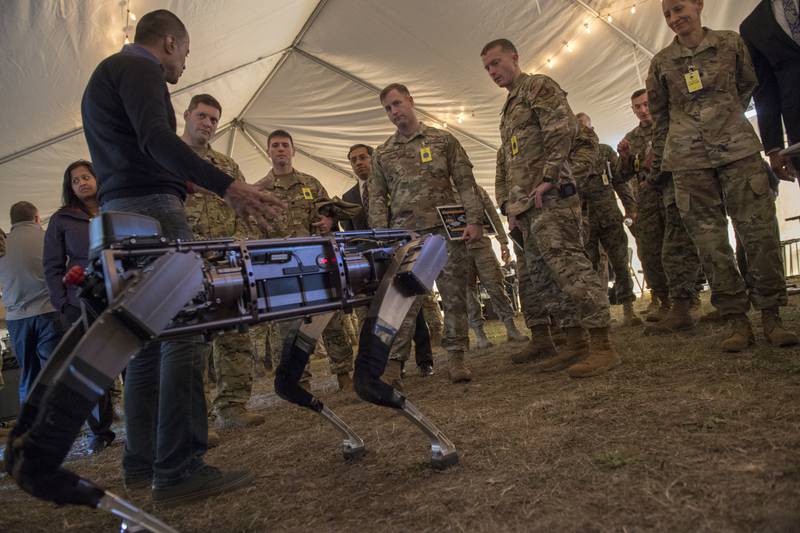WASHINGTON — Since Air Force Chief of Staff Gen. Dave Goldfein took over as the service’s top general in 2016, the Air Force has made figuring out how to connect its weapons with those of the Army, Navy and Marine Corps its biggest priority.
The Air Force is set to have spent $300 million on the Advanced Battle Management System through fiscal year 2021. However, the service is still struggling to define what ABMS needs to do and how much it will cost, the Government Accountability Office said in a report released April 16.
"The Air Force has not established a plan or business case for ABMS that identifies its requirements, a plan to attain mature technologies when needed, a cost estimate, and an affordability analysis. … To date, the Air Force has not identified a development schedule for ABMS, and it has not formally documented requirements,†it read.
RELATED

That could have significant consequences for the program down the road, GAO continued:
“GAO’s previous work has shown that weapon systems without a sound business case are at greater risk for schedule delays, cost growth, and integration issues.â€
The GAO made four recommendations: create a cost estimate and a plan laying out how to afford the program, formalize the decision-making authorities of those involved in ABMS, and develop a list of technologies that are expected to fit into the initial system.
In a response to the report, Kevin Fahey, the assistant secretary of defense for acquisition, concurred with all four recommendations — a sign that, going forward, the Air Force may be required to solidify more of its ABMS plans.
The Air Force has maintained that the program’s unconventional structure and methodology is a feature, not a bug.
It wants to use a series of experiments to help discover and mature new technologies that can be weaved in alongside legacy platforms. For instance, the first ABMS experiment connected SpaceX’s Starlink constellation with an AC-130 gunship, and the next demo will employ a Kratos Valkyrie drone carrying communications gear that enables the F-22 and F-35 to securely share data while allowing them to maintain stealth.
Air Force officials have said technologies that are proven to be successful and mature during the experiments could become programs of record inside the ABMS family of systems.
However, the Air Force does not seem to have a firm plan for what technologies it needs and when to bring them online, the GAO said. The service has identified 28 development areas that includes a new cloud network, a new common radio, and apps that provide different ways of presenting and fusing data. However, none of those areas are linked to specific technical requirements, and the Air Force hasn’t explained what organizations are responsible for the development of those products.
In one damning section, GAO compared ABMS with several cancelled programs with similar aims, such as the Army’s Future Combat Systems program that sought to field a family of manned and unmanned technologies and the Joint Tactical Radio System, which was intended to create a government-owned software defined radio. These programs publicly flamed out after millions of dollars were spent in development, in part because certain technologies were not mature enough and caused the schedule to unravel.
The scope of ABMS will be far larger than those previous programs, the Pentagon’s Office of Cost Assessment and Program Evaluation told the GAO. But because the Air Force has not provided a detailed acquisition strategy, CAPE does not have confidence that the Air Force will be able succeed where those programs have failed.
“Given the criticality of the battle management command and control mission and the planned retirement of legacy programs, the lack of an ABMS business case introduces uncertainty regarding whether the needed capabilities will be developed within required time frames,†the GAO said.
Figuring out who has responsibility and decision-making authority for ABMS is also a messy proposition, the GAO said.
The ABMS effort is led by a chief architect, Preston Dunlap, who is responsible for managing tradeoffs among the portfolio of technologies and guide experimentation efforts. However, existing programs that will be part of the ABMS family will retain their separate program office with their own independent management, and the Air Force has yet to clarify whether Dunlap will be able to redirect those program’s funding to fall in line with ABMS objectives.
For example, the Air Force’s program office for space is currently working on a data integration project that could correspond with ABMS efforts to field a cloud network.
But “although some ABMS funds have been obligated for this project, there is no documentation to support that the Chief Architect will be able to direct the PEO to change the project objectives or timeline to align with ABMS requirements once they are defined,†the GAO said.
The role of the Air Force Warfighting Integration Capability or AFWIC, which was established in 2017 to help define how the service will fight wars in the future, is also unclear. An AFWIC senior official told the GAO that the organization began leading the service’s multidomain command and control initiatives in 2019, but it is uncertain whether AFWIC also has the power to change the direction of the ABMS program.
Valerie Insinna is Defense News' air warfare reporter. She previously worked the Navy/congressional beats for Defense Daily, which followed almost three years as a staff writer for National Defense Magazine. Prior to that, she worked as an editorial assistant for the Tokyo Shimbun’s Washington bureau.








